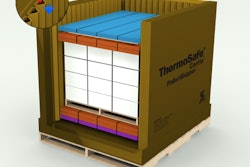
A cold chain maintains temperature-sensitive products within specified temperature ranges throughout transportation, storage, and handling, with packaging playing a pivotal role. By category, foods and beverages come most readily to mind; however, other temperature-sensitive products include pharmaceuticals, healthcare, biotech, and electronics. Equally as diverse as the categories are the required temperatures, ranging from controlled ambient to freezing (deep-frozen and packed-in-liquid-nitrogen are further ranges but not discussed herein).
Keeping one's cool
Insulated corrugated shipping boxes are a staple for some categories, especially those shipped via parcel post, a characteristically rough-handling environment; therefore, the boxes should be adequately sturdy. The specific components vary, but what insulated corrugated shipping boxes have in common is interior foam inserts (four sides, top, and bottom) that protect the product by cushioning. The foam additionally provides insulation, both against the intrusion of warmer exterior temperatures and the escape of cooler interior temperatures (the result of one or more packs of frozen gel refrigerant). Insulated corrugated shipping boxes are self-contained systems; even so, their service lives are comparatively short (for one thing, the gel refrigerants thaw), necessitating that delivery be made (ideally) overnight.
When the need is to be cooler--make that, consistently cooler--the discussion turns to refrigeration. By nature energy-intensive, that fact takes on additional significance in the sustainability era: temperature-compromised cargo represents a squandering of materials, resources, and energies. Constant monitoring of temperatures throughout the cold chain is of the utmost importance, achievable with a combination of recording devices and software programs.
Unlike a cold-storage warehouse, for example, much of what occurs in the transportation environment is not as easily observable; nonetheless, packaging's role can be aided by a few acknowledgements.
First, whether the refrigerated conveyance is via truck, railcar, or intermodal container, it is not the purpose of such "reefers" to cool the cargo; rather, the purpose is to maintain the coolness of cargo that was at the proper temperature when loaded. But such is of limited value if the equipment does not arrive pre-cooled at the proper temperature. It points to poor communications and a lack of professionalism when equipment arrives at the docks not precooled and loading has to be delayed until precooling is achieved. In the event that the cargo has been staged in anticipation of a specific arrival time of equipment, that cargo should not remain exposed to elevated temperatures while the equipment is precooling. It's better to return the cargo to cold-storage than to risk thermal damage.
Second, refrigerated equipment maintains targeted temperatures by air circulation; therefore, it's best that the cargo be exposed to that circulation on all (6) sides. Thoughtfully designed pallet patterns and load patterns accommodate that aim.
Frozen solid, or, rather, frozen solidly
Freezing arrests the growth of microorganisms, and for that very reason imposes its own set of concerns. If thawing occurs, the growth in microorganisms renews and can be a hazard, even if refreezing occurs; therefore, the potential ill-effects from cycles of freezing, thawing, and refreezing require little imagination to appreciate. Safeguards against such occurrences come chiefly through strict temperature control and monitoring throughout the cold chain; even so, packaging is vital to the quality of frozen cargo in a number of ways.
Its function as a means of preservation notwithstanding, freezing can promote dehydration, for example, in the form of freezer burn, a phenomenon that can be minimized by the proper choice of packaging. Freezing can cause the buildup of frost inside the packaging and on the product, and although frost is more unsightly than harmful, it also can be minimized by the proper choice of packaging. Incidentally, something that freezing and packaging have in common is that they can't increase the initial quality of a product; that is to say, a high-quality frozen product was of high quality at the time it was packaged and frozen.
Packaging's communication function is vital for frozen cargo, particularly concerning corrugated shipping boxes. Such containers should carry codes that facilitate the identification of contents in addition to facilitating the rotation of stock. And so as not to leave it to assumption, it's a good practice to convey on the boxes recommended storage temperatures. Even more information can be communicated with the use of RFID (radio-frequency identification), from load-specific, to case-specific, to lot-specific.
When the product is a frozen food, retail-ready (or retail-friendly) is a valued feature of the outer packaging. An example is frozen food meant to be displayed in horizontal freezers. If the product is packed upside down in the corrugated shipping boxes, the boxes can be inverted, emptying their contents upright. It's a simple concept, to be sure, but a labor-saving one, and that's what retail-ready packaging is all about.
When things get hot
If the late, great comedian, Henny Youngman had been a product in a cold chain, his signature line might have been, "Take my temperature, please." But it's not all about the control and recording of temperatures: the results have to be conveyed to the right parties in a timely (ideally, real-time) basis. To open a transportation conveyance and learn for the first time that the temperature data logger indicates thermal abuse is so after-the-fact.
Returning the discussion to packaging-specific matters, it should be kept in mind that there are various standards (whether, promulgated by ISTA, the UN, ISO, or other entities) that address the performance of packaging under cold chain conditions. Additionally, there are various laboratories that specialize in testing against a given standard(s). As previously mentioned, cold chains (refrigerated and frozen) are energy-intensive, and, thereby, more expensive than conventional supply chains (all things being equal except temperature control). No need to lavish more on packaging than is necessary, remembering that whether the packaging is adequate for anticipated temperatures is a matter--one might say--of degree, be it Fahrenheit or Celsius.
__________________________________________________________________________________________
Sterling Anthony is a consultant, specializing in the strategic use of marketing, logistics, and packaging. His contact information is: 100 Renaissance Center- P.O. Box 43176; Detroit, MI 48243; 313-531-1875 office; 313-531-1972 fax; [email protected]; www.pkgconsultant.com

























